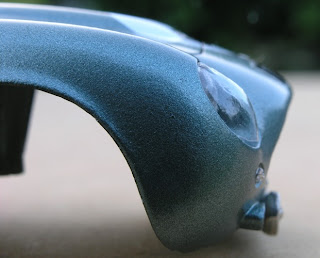 The covers on the Zagato seem to have a bubble to them, with the top part following the wingline and the bottom part having almost a flat to it, with something of a rounded point to it where the two lines meet. I think i've captured a little of the fullsize, but they are as ever a bugger to fit. One side seems slightly wider than the other. The patterns are not fixed into the plinth but are an interference fit allowing removal for further work. As can be seen below they need it.
The covers on the Zagato seem to have a bubble to them, with the top part following the wingline and the bottom part having almost a flat to it, with something of a rounded point to it where the two lines meet. I think i've captured a little of the fullsize, but they are as ever a bugger to fit. One side seems slightly wider than the other. The patterns are not fixed into the plinth but are an interference fit allowing removal for further work. As can be seen below they need it. The car overall however, is looking good. Sprayed in Ford Forest green, which is a good close approximation to the original Almond green, it's now starting to mature. The paint i've used in this instance is a polyester and strictly speaking is a base coat that should have a clear laquer over the top. Ive never been a fan of clear laquer on any model as I think too much paint causes the crispness of shut lines and detail to be lost. Obviously spraying through an airbrush means less paint goes on and the detail is there in all it's glory.
The car overall however, is looking good. Sprayed in Ford Forest green, which is a good close approximation to the original Almond green, it's now starting to mature. The paint i've used in this instance is a polyester and strictly speaking is a base coat that should have a clear laquer over the top. Ive never been a fan of clear laquer on any model as I think too much paint causes the crispness of shut lines and detail to be lost. Obviously spraying through an airbrush means less paint goes on and the detail is there in all it's glory. The car depicted is one of the two Zagatos entered in the the 1961 Le Mans 24 Hours, by John Ogiers Essex racing Stable. The vent flash shown is not correct as they were removed for the race, which was an unhappy event for both cars. 1 VEV, driven by Jack Fairman and Bernard Consten retired after twenty two laps and 2 VEV driven by Lex Davison and Bob Stilwell ground to a halt three laps later. Both cars retiring with blown head gaskets. They were never really competitive as their weight was always against them and with the appearance of the Ferrari 250 GTOs, their days as serious contenders were numbered.
The car depicted is one of the two Zagatos entered in the the 1961 Le Mans 24 Hours, by John Ogiers Essex racing Stable. The vent flash shown is not correct as they were removed for the race, which was an unhappy event for both cars. 1 VEV, driven by Jack Fairman and Bernard Consten retired after twenty two laps and 2 VEV driven by Lex Davison and Bob Stilwell ground to a halt three laps later. Both cars retiring with blown head gaskets. They were never really competitive as their weight was always against them and with the appearance of the Ferrari 250 GTOs, their days as serious contenders were numbered.Graham








